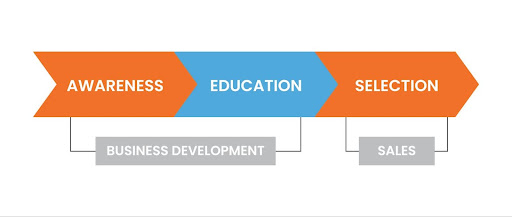What is a Business Development Representative?
A Business Development Representative (BDR) is a crucial asset within the sales team, tasked with the responsibility of discovering and cultivating new business opportunities. Employing various strategies such as cold emails, cold calls, networking, and social selling, the BDR focuses on initiating connections with potential clients. This role is integral to the broader Business Development process, which revolves around identifying strategic opportunities for organisational growth and partnerships in SaaS marketing front, primarily within the realm of lead generation for the sales team.
Forbes states that Business Development Representatives (BDRs) help organizations generate value from their customers, markets, and relationships in the long run. By identifying opportunities for development and expansion, business development professionals add long-term value to companies. They identify and establish connections with potential clients or consumers using a variety of techniques, such as cold calling, emailing, and networking. Determining whether this employment is suited for you can be aided by knowing the scope of this employee.
This article explains the duties of business development agents, draws comparisons between jobs in sales and business development, and offers advice on how to get into the field.
Functioning as the frontline liaison with potential customers, a BDR is the initial touchpoint in establishing relationships. Their role extends beyond lead generation to ensuring the quality of leads, contributing significantly to the scalability and expansion of a business. Typically reporting to a business development manager, BDRs employ metrics such as scheduled meetings and recruited prospects to gauge their progress. Additionally, BDRs may explore avenues to enhance overall business operations, ranging from optimising inventory practices to implementing innovative approaches that align with the company's growth objectives. In essence, the BDR's proactive engagement marks the inception of valuable connections, setting the stage for the subsequent stages of the sales process.
Where BDRs Provide Invaluable Value
For any organisation aiming to create inbound opportunities, BDRs prove invaluable. They ensure the optimization of every channel and leverage them to provide a continuous flow of leads. It's crucial to note that while BDRs generate leads, the conversion is the responsibility of the sales team. BDRs play a pivotal role in supporting sales reps by developing a robust inbound saas marketing strategy. They don't focus on organic leads but instead hunt for new, untouched opportunities, acting as the front line of the company to spark interest in those who might not yet realise their need for the solutions offered.

BDRs: Three Main Outcomes
1. Identify New Leads:
BDRs act as prospectors, uncovering hidden opportunities in untapped markets. Their strategic vision allows them to identify potential customers who may not be reached through conventional methods.
2. Qualify Them:
Once leads are identified, BDRs employ their skills to meticulously qualify them. This involves understanding customer profiles, needs, and motivations, and ensuring that the leads align with the business's objectives.
3. Connect Them to Senior Sales Members:
BDRs serve as the bridge between the initial spark of interest and the final conversion. They nurture connections and deliver qualified leads to senior sales members, allowing the latter to focus on the critical task of closing deals. While BDRs serve as the bridge between the initial spark of interest and the final conversion, differentiating between Demand Generation and Lead Generation is essential in understanding their distinct roles within the broader spectrum of strategic SaaS marketing in a startup with efforts.
What does a BDR do?
In a company's sales ecosystem, a business development representative (BDR) is essential to the critical process of obtaining and assessing leads. Their primary goals are locating outside leads and creating lead creation plans in order to spot possible clients and business growth prospects.
Doing thorough due diligence to enlighten prospective clients or purchasers is one of the BDR's main duties. This entails creating and keeping an extensive database of leads that lists important decision-makers in the intended organisations. Equipped with this data, BDRs utilise several communication platforms, including social media, phone conversations, emails, and more, to establish connections with prospective leaders and launch networking events. Within these networks, the b2b business offers and distinguishes the particular requirements of potential customers.
One of the most important parts of the BDR's job is qualifying leads. This means assessing a lead's degree of interest, ability to pay, and preparedness to interact with the sales staff. BDRs provide a targeted and effective distribution of sales resources by evaluating whether a lead fulfils the requirements for a possible income stream.
In order to create a b2b environment where sales encounters are effective, the BDR is essential. They set up meetings or conferences with qualified leads form your b2b saas marketing strategy and supply crucial data and proof to bolster the efforts of the sales team. Working together is essential because BDRs and the sales team enable a seamless transfer of qualified leads. They also integrate insightful input from interactions with prospects to improve message and targeting tactics.

Skills Driving Success in the Unknown
1. Communication:
Effective communication is paramount for BDRs. They must articulate the value proposition, build rapport, and convey complex ideas in a compelling manner.
2. Organisation:
Navigating untapped markets requires meticulous organisation. BDRs manage tasks from research and lead generation to networking and social selling.
3. Strategy Building:
BDRs are strategic visionaries, crafting blueprints for opportunity and growth. They develop and execute effective strategies for lead generation following your saas marketing mix, adapting them to the ever-shifting landscape within their saas marketing budget.
4. Interpersonal Skills:
In the multifaceted role of a BDR, interpersonal skills are crucial. They act as ambassadors, storytellers, and relationship builders, establishing trust and connection.
Measuring BDR Success: Metrics that Matter
Measuring BDR success involves tracking various metrics specific to the company's goals. Metrics may include the number of interactions, percentage of conversions, revenue generated through different channels, and the frequency of interactions with leads. This comprehensive approach allows businesses to gauge the effectiveness of their BDR team across different parameters.
Soft Skills Shaping a Successful BDR
The role of a BDR is not merely about knowledge but also about soft skills that drive success in the face of challenges. Four crucial soft skills include:
1. Creativity:
BDRs need to come up with original ideas to connect with their audience and respond creatively to objections, setting them apart from competitors.
2. Adaptability:
Dealing with different people from various backgrounds requires adaptability, helping BDRs create connections regardless of unexpected turns in conversations.
3. Active Listening:
The ability to hear the unspoken message and capture what someone is trying to communicate allows BDRs to address objections early and establish a genuine connection.
4. Persistence:
BDRs face rejection regularly and need the patience and persistence to keep going. Understanding the long-term nature of business development, they continue working towards generating the expected results.

BDR vs. SDR
In the dynamic realm of sales, BDR and SDR emerge as key players, each contributing uniquely to the intricate sales landscape. SDRs in a b2b marketing agency specialize in mastering the intricacies of inbound leads, deftly qualifying prospects generated through diverse marketing channels. These gatekeepers of the sales cycle at Saffron Edge, a b2b marketing agency, meticulously transition qualified leads, paving the way for Account Executives to seal deals.
On the other front, BDRs don the hat of explorers, venturing beyond conventional boundaries. Their mission extends into uncharted territories, employing outbound strategies to identify and qualify new opportunities. BDRs architect expansion, crafting potential avenues for growth by proactively seeking untapped markets.The synergy between SDRs and BDRs creates a collaborative symphony in the sales landscape. SDRs efficiently manage inbound leads, ensuring their seamless transition, while BDRs infuse vitality by exploring new territories, injecting fresh prospects into the sales pipeline. This collaborative edge optimises the sales funnel, presenting a holistic approach to lead generation.
Adaptability becomes the hallmark as SDRs navigate the influx of leads, and BDRs strategically venture into unexplored markets. Their complementary roles position a sales team to thrive amid evolving market dynamics, marking a nuanced and effective strategy in the ever-shifting terrain of business growth.
The Business Development Process: A Long-Term Investment
Effective long-term business development strategies encompass a multifaceted approach aimed at sustainable growth. Understanding the market dynamics is foundational. It transcends mere data analysis, emphasising empathy and immersion in the audience's world. Regular market research becomes the compass, revealing trends, opportunities, and threats that empower strategic adjustments to the value proposition, ensuring relevance and resonance.
- Building a robust network is the second pillar of enduring business development. It surpasses the exchange of business cards, delving into the realm of meaningful relationships that open doors, generate referrals, and provide a crucial support system. Online and offline networking across various platforms cultivates connections that extend beyond transactional interactions, fostering a community of collaboration.
- Innovation in products and services serves as the third strategy. It's not merely about technological advancements but centres on creative problem-solving, value addition, and differentiation. Leveraging customer feedback, data, and insights helps identify gaps, propelling innovative ideas that align precisely with evolving customer needs.
- Expanding reach to new saas markets, SaaS Marketing customer journey, or channels constitutes the fourth strategy. This diversification of revenue streams requires meticulous planning, research, and adaptation of products, services, and saas marketing strategies to suit new environments using organic growth services like SEO and Account based marketing. This deliberate approach ensures successful expansion with minimised risks.
- Investing in the team emerges as the fifth strategy, recognizing the team as the most valuable asset. Providing them with skills, tools, resources, and incentives creates a culture of collaboration, fostering engagement, motivation, and retention. This, in turn, leads to improved productivity and attracts top talent, essential for sustained success.
- Evaluating results and measuring progress forms the penultimate strategy. Beyond financial metrics, key indicators like customer satisfaction, loyalty, and referrals offer insights into the effectiveness of business development efforts. Informed decisions and adjustments based on this evaluation contribute to continuous improvement.
- The final layer involves tracking results through SMART KPIs. Metrics such as generated leads, won deals, total revenue, and new penetrated markets provide actionable insights. Regular evaluation ensures informed decision-making and ongoing optimization, culminating in a holistic and effective long-term business development strategy.
In the broader perspective, the business development process is portrayed as a long-term investment. Integrating a business development representative into the team signifies a commitment to growth, requiring a deep understanding of the process.
Thorough research, creative expansion of reach, and recognition of the energy-intensive nature of business development become crucial elements. This collective effort, supported by senior leaders and sustained motivation, positions the business for exploration, expansion, and transformative growth in the dynamic b2b landscape. Hire SaaS marketing experts to lead in the digital landscape.

Conclusion
In conclusion, the role of a Business Development Representative (BDR) is pivotal in the intricate landscape of sales, acting as the catalyst for discovering and cultivating new business opportunities. Through a strategic blend of communication, organization, and adaptability, BDRs navigate uncharted territories to initiate connections and contribute significantly to the scalability and expansion of a business. Their proactive engagement, measured through various metrics, marks the inception of valuable relationships, setting the stage for subsequent stages in the sales process.
The broader perspective reveals the business development process as a long-term investment, where effective strategies encompass understanding market dynamics, building robust networks, innovating products or services, expanding reach, investing in the team, and consistently evaluating results coming through SaaS SEO and saas semantic seo. By integrating these multifaceted approaches, businesses position themselves for exploration, expansion, and transformative growth in the dynamic and competitive business landscape. The commitment to growth, supported by senior leadership and sustained motivation, ensures that the business development process becomes not just a series of transactions but a strategic journey toward enduring success.
Saffron Edge, a saas marketing agency, emerges as a distinguished B2B marketing agency which offers a dedicated team of Business Development Representatives (BDRs) to fortify your brand’s outreach. Elevate your strategy with us and let our BDRs chart a course for unparalleled success in the B2B landscape.
Subscribe to our newsletter
Get fresh stories, case studies, and
advice
from successful creators and industry experts.

Subscribe now






